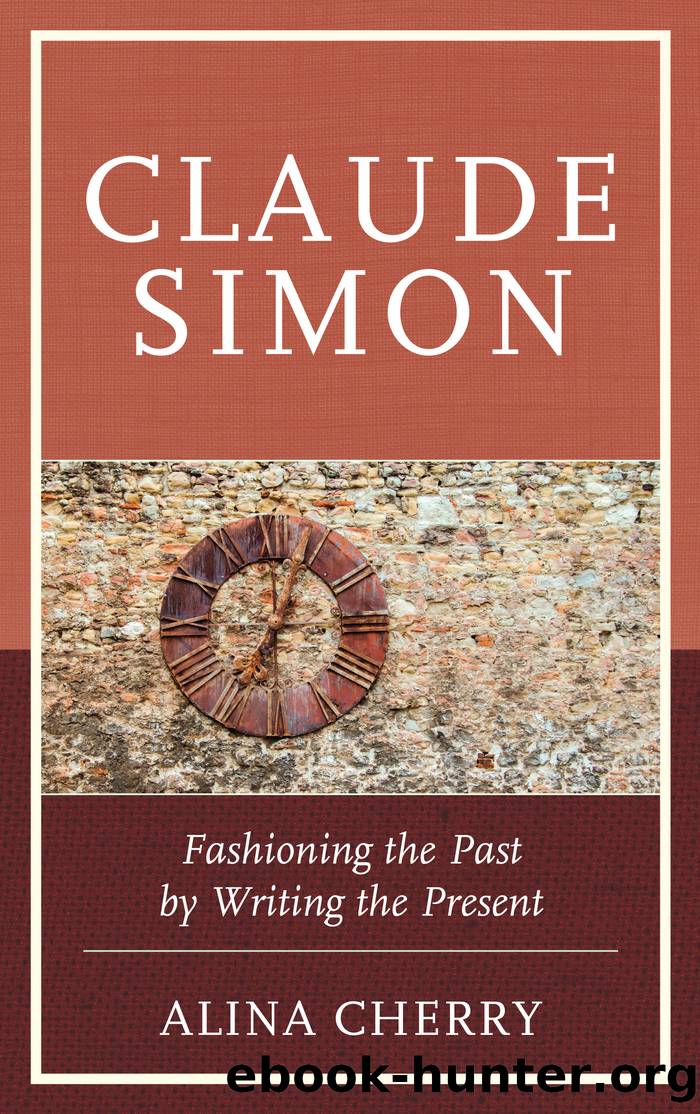Claude Simon by Cherry Alina

Author:Cherry, Alina
Language: eng
Format: epub
Tags: undefined
Publisher: Fairleigh Dickinson University Press
Published: 2012-08-15T00:00:00+00:00
Windows on Multiple Temporalities
Like the General’s documents and Marie’s account books, the postcards in Histoire can be categorized as written artifacts that someone—the narrator-protagonist in this case—inherits from a family member. Unlike the traces in The Georgics and The Grass, the universe of the postcards confronts the narrator with a semiotic multidimensionality that solicits his attention in new, plural ways. Situated at the confluence of two different media, text and image, as well as of the private and public domains, since they represent an “open” correspondence, these “double-sided documents,” as Jean Rousset called them, elicit close examinations from the narrator.[49] He devotes ample scrutiny to each component of the postcard’s semiotic makeup: the images on recto, the texts on verso, the legends that accompany the images, the stamps, and the postmarks.
Hence, most of the resulting descriptions are textual translations of visual elements (illustrations and stamps), descriptions whose linear, consecutive syntactic organization converts the instantaneous reading of an image, which is as close to simultaneous perception as a reading can get, into the sequential reading of a text. Acutely aware of this impediment, Simon is constantly on the lookout for stratagems to transgress it, keen on conveying an impression of simultaneity. My analysis will focus on three such transgressive modalities, each involving a particular aspect of the narrator’s reading of the postcards. The first one addresses the study of the postcards as multiplicities, as clusters of distinct signifying units. Through this approach, the narrator lessens the focus on the linguistic linearity of the descriptions and alternately plays up the postcards’ layered temporality and spatial heterogeneity. Second, with regard to the overall organization of Histoire—which exhibits a form rarely adopted by Simon, the chronological plot—the postcards act as a structuring device that aims to undermine the temporal linearity of the novel. In the third place, as illustrations of a universe frozen in time by means of modern technology, these shots “seem to deny time, giving the illusion that the photograph is one of [. . .] those knifelike slices made in duration” (H 226); consequently, they provide an ideal arena for Simon to experiment with his concept of “dynamic description” that seeks to introduce movement, hence temporality, into an immobile frame. No longer simply mimetic, these dynamic descriptions offer instead a testimony to the creative exchanges and tensions generated in the present of writing, as the image of the postcard stimulates the writer’s imagination into transgressing its contours.
Each postcard is presented as an eclectic space divided into several parcels: the face occupied by the illustration, the areas reserved for the sender’s message, the stamp, and the official seal all highlight the postcard’s “standardized and stereotypical character that results from its mass production.”[50] Additionally, to each of these spatial components corresponds a gesture that marks a particular point in time: the perpetual present of the image immobilized by the mechanical eye of the camera, the spontaneous mood of a fleeting instant seized in the writing of the message, the calendar date imprinted by the postal seal.
Download
This site does not store any files on its server. We only index and link to content provided by other sites. Please contact the content providers to delete copyright contents if any and email us, we'll remove relevant links or contents immediately.
The Fine Print (Dreamland Billionaires Book 1) by Lauren Asher(2394)
Fury of Magnus by Graham McNeill(2362)
The Last House on Needless Street by Catriona Ward(2179)
The Rose Code by Kate Quinn(2072)
Malibu Rising by Taylor Jenkins Reid(1802)
Luster by Raven Leilani(1799)
Transcendent Kingdom by Yaa Gyasi(1766)
A Little Life: A Novel by Hanya Yanagihara(1736)
Moonflower Murders by Anthony Horowitz(1719)
The God of the Woods by Liz Moore(1559)
The Lost Book of the White (The Eldest Curses) by Cassandra Clare & Wesley Chu(1508)
This Changes Everything by Unknown(1421)
The Midwife Murders by James Patterson & Richard Dilallo(1376)
The Lying Life of Adults by Elena Ferrante(1347)
The New Wilderness by Diane Cook(1333)
Written in the Stars by Alexandria Bellefleur(1317)
Wandering in Strange Lands by Morgan Jerkins(1279)
Ambition and Desire: The Dangerous Life of Josephine Bonaparte by Kate Williams(1273)
The Lying Life of Adults by Elena Ferrante;(1230)
